Abstract
The article considers the functioning of such a genre form of contemporary folklore as a meme. It describes the peculiarities of a meme as a speech genre form created and functioning in social networks: thematic, stylistic, compositional. We noticed that the main feature of a meme is a comic reconsideration – connected with a socially meaning event or a socially meaningless image. The empiric base of the research comprised the memes devoted to the topical event, which became the impulse to launch a new key word moment in the international speech space –
Keywords: Comiccurrent key wordInternet communicationmemesemantic shiftsocial stress
Introduction
The Internet space as a special speech environment bears the unique system of speech genre forms. The laws of that system help the Internet communication develop which at present makes a significant influence on the organization of interaction in media – compositional and speech one. The compositional one is on the peculiarities of perception and as the result onto the demands to the text. The speech aspect is on the language in the whole – for example, the word acquires new usage meanings (Baghana et al., 2019; Tanaka et al., 2017): the formation of the layer of acute vocabulary – the current key words.
In this case we are interested in the meme, which constantly draws the attention of the researchers (Benavides-Vanegas, 2020; Bou-Franch & Blitvich, 2019 Dawkins, 1976 (the theory of memes); Dean, 2020; Gualberto et al., 2020; Kassing, 2020; Kepa-Figura, 2019; Nagel, 2020; Prokofeva & Shcheglova, 2020; Surikova, 2020; Ye Kyung & Crowder, 2019). The uniqueness of the research is that the focus of the attention is on the memes with the key word of the current moment, which is
We consider the meme as a speech genre in the unity of visual and speech components. The combination of the genre signs is the following: 1) thematically the meme correlates to the significant political and social events, allowing to find the reason for comic reconsideration or is a comic reconsideration of non-urgent image; 2) stylistically the meme longs to the colloquial speech design, without any literary frames: they often use the deliberate corruption of the word form, rough simple vocabulary, even obscene vocabulary; 3) compositionally memes are the unity of visual and speech components, each element adds to the other one, performing the main communicative purpose – gradually making the situation absurd.
The meme is called to invite people to mutual laughter, i.e. its functionality is defined with drawing the addressee into the intellectual game, emotional relaxation, creating an entertaining moment.
Problem Statement
The comic effect is often based on the contradiction observed in the surrounding reality. The contrast, dissension, opposition within the comic situation (Borev, 1970) are presented excessively, provoking the laughter. It is important to notice that the laughter itself is conditioned socially and historically. Each epoch bears its forms and genres of the comic effect and actualizes the old ones. The comic effect is able to solve many social problems, their character being in correlation with the current demands: clarifying the true order of things, transferring the hidden sense, social relaxation etc. The features of the comic presentation in memes, in our opinion, demonstrate all that.
The comic reconsideration in memes is presented with two forms: content and speech (it is similar Propp, 1997).
The content in memes is shown with the violation of logical laws. The task of the comment is to make the situation absurd. It is often possible due to the background knowledge and hidden senses play. The speech plan in the conflict includes the image and the stylistic response of the comment, which does not relate to it.
We notice that on the one hand the multicodeness of the meme provides a mutual meaning refinement of the speech and visual components, on the other hand –there is a phenomenon of the self-existence of the both. The visual or speech components possessing a greater potential of meaning-production, it is spread in other memes, getting known and helping to create new language and logical games and to form the usage meanings of the key word.
Thus, in the center of the given research there is a meme, which is considered as an acute in the Internet-communication speech genre of the comic sphere. They usually speak about the entertaining function of the meme in the Internet-communication. We consider that the meme is an integral resource for the net communication, possessing the multi-functionality and a high degree of adaptation to the demands of the audience (the transformation of visual and verbal components). In the case of memes with acute images we deal with a universal multicode system, able to solve such difficult problems as the social relaxation (from fear, hatred, meanness etc.). Frequently it happens through the game with multicode meanings, gathering around the key vocabulary of the agenda.
Research Questions
Purpose of the Study
The purpose of the given research is the search for speech mechanisms of social relaxation (on the example of fear of illness) in memes with the current key word
Research Methods
The empiric material of the research is the combination of memes (Russian and English), which appeared in connection with the spread of Corona Virus in the world (February – March 2020). The simultaneous rise of the threat and the number of messages about in media lead to the feeling of fear rising in the society. The line of words for representation of the new threat is formed inside the media discourse, provoking the feeling of helplessness; the central of those words is the nomination of the threat –
The methodological foundation for the research is, on the one hand, the method of characterizing the speech genre, on the other hand, we developed the method of linguistic stylistic analysis of key words functioning in media space, based on the semantics and pragmatic of its usage. As the word Corona Virus relates to the semantic field “Disease” developing in the language world view, the key word in the given case was able to form the own lexical semantic field. This feature was also considered in the meme analyses.
The primary analysis of memes, devoted to Corona Virus demonstrated the possibility to continue the research with the following classification of types of interaction between the author and the key words:
The address to the new form of the word, the sound form (homonymy, paronymy).
The address to the inner content, semantics (polysemy, the use of acute connotative meanings of the key word, the elements of the lexical semantic field, formed by it).
Findings
The address to the sound form of the word
The simplest type of the game with the sound form of the key word is based on the paronymic attraction (Figure
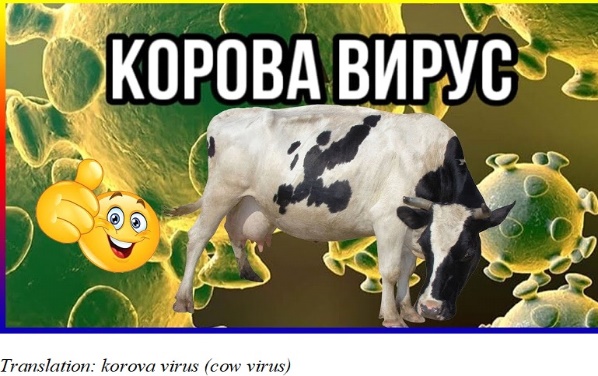
The non-language paronymy of the words corona andkorova allowed the author of the meme to produce the simple replacement of one element with the other. The incompatibility of notions for each word created the comic paradox, supported with the image of a cow against the background of the Corona Virus molecule. Thus, happens the typical replacement of notions, when a more emotionally loaded one is replaced with a neutral one – the decrease of pathos Bakhtin alleviates the feeling of fear in front of danger. The play with the word form is also realized through the literacy of its parts (Fig. 02).
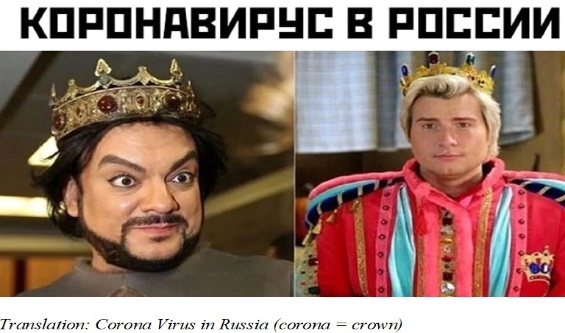
The comic reconsideration in a number of memes happens due to irony at the pop stars, who like to try the crown on. The cited example shows F. Kirkorov and N. Baskov (S. Zverev and M. Galkin in other variants). Literally understanding the morphemes in the word, Corona Virus may be interpreted as a total interest to the image of king (pop). The literacy of meanings provokes laughter decreasing the emotional stress. The additional comic effect is produced with the visual element: F. Kirkorov and N. Baskov often perform together (in advertisements, shows), playing a fake contradiction on the stage. Their mutual interest to overestimate their significance is funny and the crown is the metaphor for it.
The homonymic anecdotes are also demanded in this theme. The English memes about Corona Virus generally contain the language play, based on the coincidence of the first part of the disease name and the name of one of the most popular beer brands. The comment
The game with the beer names is absurd due to the logical line, appearing in the semantic field “a deadly dangerous disease” (Figure

The meme is the clash of two images: dramatic photo in emotional pressure – disinfectors at work and the photo of a sandy seaside with the bottle of beer affront. The contradiction of images is stressed with the contradiction of speech comments: the first – intense – photo is accompanied with the comment
Content. The address to the semantic of the key word and the elements of the semantic field
The main meaning, which is realized with the word Corona Virus, is “a dangerous disease; epidemic, pandemic”. One of the oldest ways to struggle with the panic and fear is to forbid the name of the threat, a sort of a taboo on its name (tabooed theme of death). There starts the language game in memes, based on the exception of the word Corona Virus. For example, replacing it on the omage and a certain game with the addressee in associative links (Figure
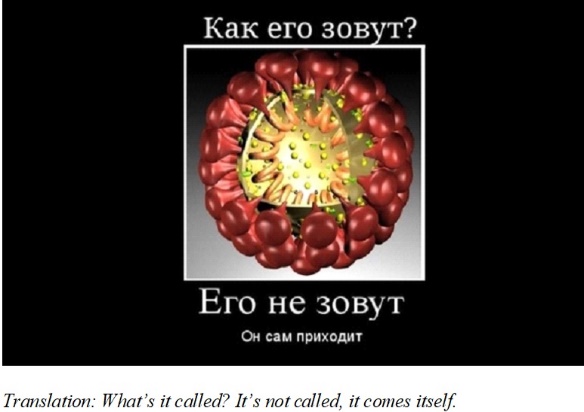
The cited meme is the response from the anecdote:
The enlarged image of Corona Virus is in the center, which creates the focus on the meaning dominant of the meme with the actual absence of the word
In a number of cases the game happens with equal meanings of the main name or its parts. The memes about Corona Virus play with two meanings of the word virus (“the reason for contagious disease” and “the computer program connecting to other programs with a negative effect”) (Figure
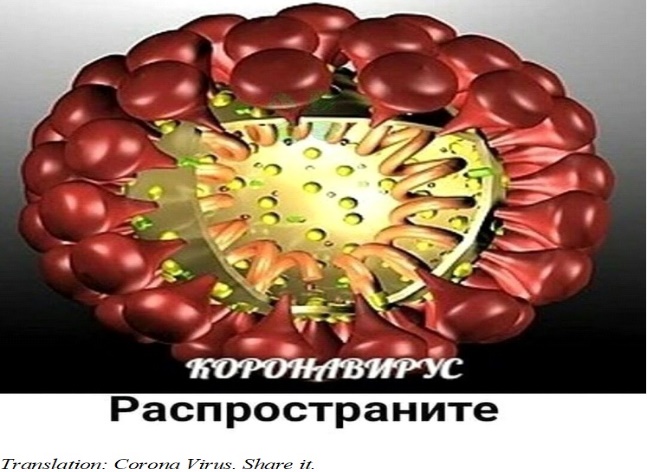
In the given case we again see the spread image of the Corona Virus molecule. To avoid the mistaken interpretation the image is supported with a sign performing the nominative function. Below the image there is a calling with the imperative verb. The absence of verbalized object referring to the predicate refers to the image and the sign above. The comic effect is created with the ambiguity of reading: to share the infection (the absurd calling) and to share the meme, to make it virus.
The spread of the “plague” theme happens in the game of elements of the semantic field “Corona Virus” – frequently this is the replacement of the medical mask as the protection means for the plague ones. There is a phenomenon, which may be defined as the graphic periphrasis – the medical mask becomes the plague one, associatively calling for the line
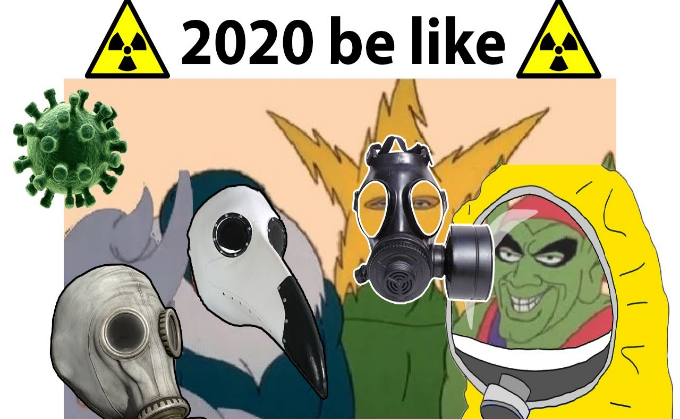
The presented meme unites several signs of different plans, creating the additional hidden meanings. The sign of nuclear danger is united with the large image of the Corona Virus molecule, which places the new disease and radiation sickness in one line (the connotative meaning “danger”). The visual component is added with the animated characters from “Spiderman” – the main villain and his dominions, wearing various protection clothes starting with a plague mask and a respirator and finishing with a body armor. The ambiguity of the comment
Conclusion
Summing up, we shall notice the following: 1) at present the meme is formed as a speech genre of the Internet-communication with the variety of speech-genre features and a complex system of variants; 2) the speech model of the genre demands a further deep study, which will allow creating the classification of the genre diversity of memes; 3) the meme exists as a comic genre, focused on entertaining and social relaxation after the influence of the agenda; 4) the reasons for the meme appearance are connected with a) the necessity of the phatic communication (communication for entertainment), b) the demand for adaptation to the stressed informational flow with a prevailing number of emotionally negative news; 5) memes help to fix the current key words in the usage; 6) connotative meanings of key words appear and lexical semantic fields of these words are spread in the result of language and logical games with the current vocabulary of the epoch; 7) memes reflect the acute language world view of the bearer with a certain mentality; 8) the analysis of memes, functioning in various language environments, shows the actualization of various associative links, different direction of language games with a significant number of contact points, considering the world agenda.
Acknowledgments
The study was conducted with the support of the grant "Humour as a communicative resource in a digital news environment" (Agreement with the RSF No. 19-18-00530 of 07.05.2019).
References
- Baghana, J., Blazhevich, Y. S., Prokhorova, O. N., Kuslova, E. L., & Yakovleva, E. S. (2019). On the Problem of Lexical Semantic Change. Journal of Research in Applied Linguistics, 10, 320-326. DOI:
- Benavides-Vanegas, F. S. (2020). Emoticons, memes and cyberbullying: gender equality in Colombia. Social semiotics, 30(3), 328-343. DOI:
- Borev, Yu. B. (1970). Сomic. Iskusstvo.
- Bou-Franch, P., & Blitvich, P. G.-C. (2019). Analyzing Digital Discourse. New Insights and Future Directions. Palgrave Macmillan. DOI:
- Dawkins, R. (1976). The Selfish Gene. Oxford University Press.
- Dean, R. (2020). Durrr-dur-dur-dur-dur-durrrr-durrrrrr: more than just White Stripes. Sport in society, 1-15. DOI:
- Gualberto, C., dos Santos, Z. B., & Meira, A. C. (2020). Multimodal metaphors: from language as a condition to text to the notion of texture as a meaning-making semiotic resource. Revista de estudos da linguagem, 28(2), 893-915. DOI:
- Kassing, J. W. (2020). Messi hanging laundry at the Bernabeu: The production and consumption of Internet sports memes as trash talk. Discourse context & Media, 34, 100320. DOI:
- Kepa-Figura, D. (2019). (Internet-)mem as a new media genre. Questions' statement. Media linguistics, 6, 103-121. DOI:
- Nagel, K. W. (2020). Make America Meme Again: The Rhetoric of the Alt-Right. Quarterly journal of speech, 106(2), 216-219. DOI:
- Prokofeva, N. A., & Shcheglova, E. A. (2020). Meme as a speech genre of the internet-communication. In E. F. Quero Gervilla, & N. Sokolova (Eds.), Current issues in modern linguistics and humanities. Proceedings of the 12th All-Russian Research and Methodological Conference with International Participation, Moscow, Institute of Foreign Languages, RUDN University, March 27th, 2020 (pp. 140-156). RUDN University. DOI:
- Propp, V. Ya. (1997). Problemy komizma i smekha [Problems of comic and laugh]. Alteija.
- Surikova, T. I. (2020). Demotivator in media discourse: boundaries as properties of genre. Media linguistics, 7(1), 29-50. DOI:
- Tanaka, R., Mineshima, K., & Bekki, D. (2017). Factivity and presupposition in Dependent Type Semantics. Journal of Language Modelling, 5(2), 385-420. DOI:
- Ye Kyung, S., & Crowder, J. (2019). Memes in medical education: Making sense of professional authority. Medical Anthropology Theory, 6(2), 102-119. DOI:
Copyright information

This work is licensed under a Creative Commons Attribution-NonCommercial-NoDerivatives 4.0 International License.
About this article
Publication Date
27 May 2021
Article Doi
eBook ISBN
978-1-80296-107-2
Publisher
European Publisher
Volume
108
Print ISBN (optional)
-
Edition Number
1st Edition
Pages
1-1907
Subjects
Culture, communication, history, mediasphere, education, law
Cite this article as:
Prokofeva, N., & Shcheglova, E. (2021). Comic Reconsideration In Memes As The Means Of Social Relaxation. In E. V. Toropova, E. F. Zhukova, S. A. Malenko, T. L. Kaminskaya, N. V. Salonikov, V. I. Makarov, A. V. Batulina, M. V. Zvyaglova, O. A. Fikhtner, & A. M. Grinev (Eds.), Man, Society, Communication, vol 108. European Proceedings of Social and Behavioural Sciences (pp. 292-299). European Publisher. https://doi.org/10.15405/epsbs.2021.05.02.35

